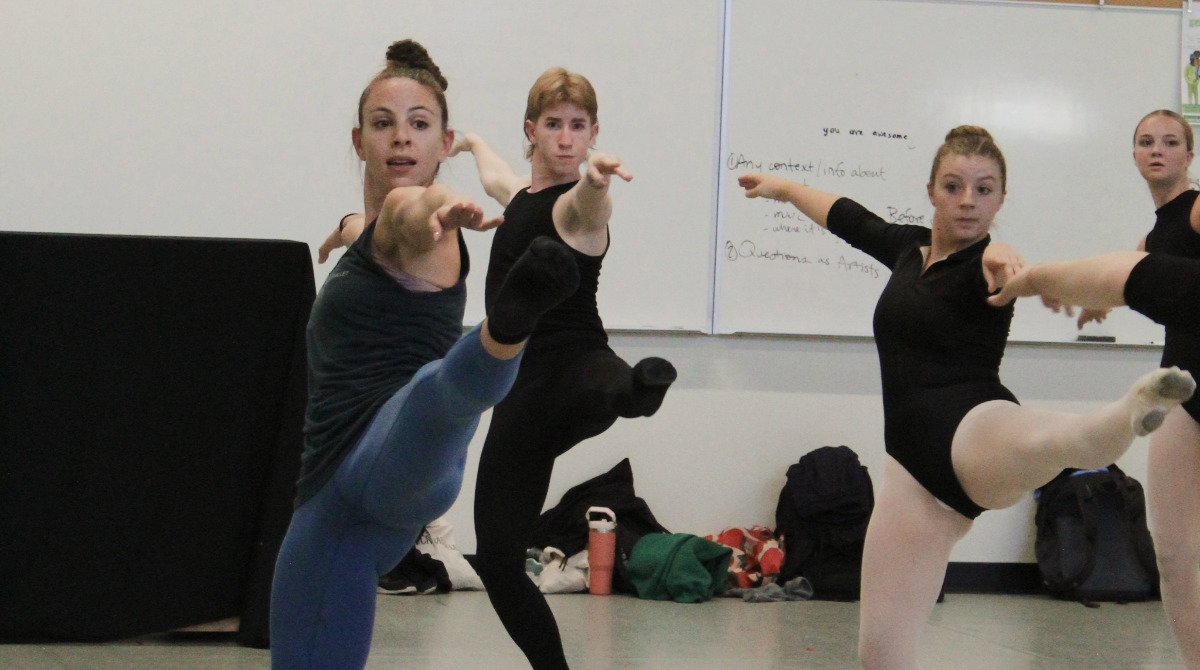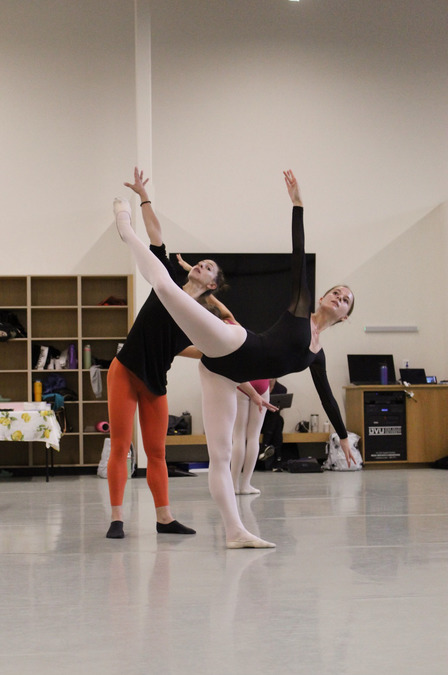Standing in a studio in the Norma T. Anderson Dance Complex at Utah Valley University, Jourdan Epstein gives the impression of being fully in control of her body, her every motion intentional.

Standing in a studio in the Norma T. Anderson Dance Complex at Utah Valley University, Jourdan Epstein gives the impression of being fully in control of her body, her every motion intentional.
Epstein — a professional performer, choreographer, and educator representing Complexions Contemporary Ballet — punctuates and fills every sentence she speaks with movement: gestures, expressions, motions of hands and arms and legs. Her cadence is rhythmic but lyrical as if matching the tempo of some music only she can hear.
Eighteen UVU dance students watch Epstein intently, absorbing everything and sometimes asking clarifying questions. As they rehearse, her eye somehow catches the movements of all 18 dancers at once, calling each by name as they move.
Epstein rarely criticizes. Instead, she collaborates, recognizing good ideas and observations and always praising effort while demanding excellence. Her stream of words and motions transforms the white-walled dance studio into a place of raw creativity.
“I will never get away from dance,” Epstein said. “I’ve tried to do other things. It is a love that feels like air when I wake up. And I love teaching the next generation.”
Based in New York City, Complexions Contemporary Ballet was founded in 1994 by master choreographer Dwight Rhoden and legendary dancer and actor Desmond Richardson. Complexions is scheduled to perform at The Noorda Center for the Performing Arts at UVU next February — but when they do, these UVU dancers studying with Epstein will take the stage alongside the pros.
This rare engaged learning opportunity is the result of two separate grants written by UVU dance professors Jamie A. Johnson and Christa St. John in partnership with Alex Malone, executive director of The Noorda.
“It's a really amazing, synergistic coming together of three different entities: the Department of Dance, The Noorda, and Complexions,” St. John said.
Johnson said Complexions had been high on their desired list of performers to bring to perform with and teach UVU’s dance students. When the opportunity arose, they made the most of it.
“We identified Complexions as a company we'd love to bring in for a longer, more engaged experience with our students,” Malone said, “Learning an entire piece, the students dancing with the company on stage, and having not just a one-day experience, but a year-long, immersive endeavor to really dive into this choreography and into this company.”
Epstein is a key part of that endeavor. She is a Complexions repetiteur, able to teach and tutor UVU’s dancers to learn some of the same professional-level works the full Complexions company performs.
“I think it really speaks to the caliber of our students and our faculty that we are able to engage in this way with a company of Complexions’ renown,” Johnson said.
“Complexions’ work is complicated,” Epstein said. “It is full body, it's mental thought, it's physical awareness. It's so many things all at once. This movement is new for dancers if you've never experienced it before, and I'm really thankful that all of the UVU dancers really put themselves out there and are exploring with me.”
The experience has been “humbling,” according to several students, who are discovering exactly what is expected of someone performing at the level of Complexions.
“Having a professional come in and treat us like we are the company members, and putting us through that standard, is helping me so that when I apply for a company, I know what to look for and how to act,” UVU junior Heather Morley said. “It's a lot of full-body movement, a lot of using your muscles and having that structure behind both classical ballet and contemporary technique and mushing it together to make these moves happen.”
Part of the challenge of Complexions’ work is that it doesn’t always conform to specific beats in the musical accompaniment. Often, the dancers must keep time mentally, following Epstein’s direction as she uses rhythmic scat syllables to correspond with different motions.
“Working with Jourdan on this piece has been extremely challenging in the best way,” UVU senior Madison Folger said. “She has really pushed our limits. She's challenged us artistically, technically, physically in every room. It has been really cool to watch her embody the movement and then be able to try and replicate that and feel this new movement vocabulary within our own bodies.”
The UVU dancers working with Epstein endured a rigorous audition process, participated in NIQUE workshops to familiarize themselves with the movement vocabulary of Complexions work, and spent a week rehearsing with her for two and a half hours every day. When the full Complexions company returns for its performance in February 2024, it will host more rehearsals and workshops before taking the stage with the UVU dancers.
“I learned this piece when I was 22 years old,” Epstein said. “I was a summer intensive student. That piece was created when I was in the room. I then performed it in the company, and 10 years later, I’m teaching it to the next generation. And I think that's a pretty cool, full-circle moment, that dance can bring all of these worlds together.”

Third region (Section 1)